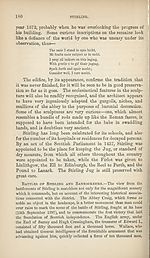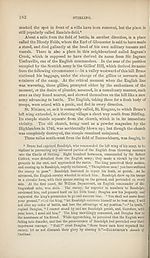Download files
Complete book:
Individual page:
Thumbnail gallery: Grid view | List view

BANNOCKBUKN.
181
and with them marched from Dundee to dispute the passage of the Forth.
The bridge oyer the river was at that time of wood, and stood half a mile
higher up the river than the present old one; over this the English army
defiled, although it was so narrow that only two could pass it abreast.
Wallace suffered a considerable number to cross without opposition, hut
when about one-half of the English forces were over, and the bridge was
still crowded with those who were following, he charged with his whole
strength, slew a very great number, and drove more into the river. The
remainder of the English army left on the southern side of the Forth fled
in great confusion, having first set fire to the bridge. Cressingham was
killed in the beginning of the battle, and the Scots detested him so much,
that they are said to have mangled his dead body and to have torn the
skin from his limbs. The country for miles around was covered with the
bodies of the fugitives. Twenty thousand men are reported to have fallen
in the battle and the pursuit.
The most illustrious place in this neighbourhood, however, or indeed
in Scotland, is the field of Bannockburn—the Marathon of the North
—which lies about two miles to the south of Stirling. Here was fought,
June 24,1314, the famous battle between the English army consisting
of 100,000 men under Edward II., and the Scottish army of 30,000,
commanded by Robert Bruce. The Scottish army extended in a north¬
easterly direction from the brook of Bannock, which was so rugged
and broken as to cover the right flank effectually, to the village of St
Ninians, probably in the line of the present road from Stirling to Kilsyth.
The royal standard was pitched, according to tradition, in a stone having
a round hole for its reception, and thence called the Bore-Stone. The
remaining fragment of this stone, protected from the depredations of
visitors by a frame-work of iron, still remains on the top of a small
eminence called Brock’s Brae, to the south-west of St. Ninians. To the
northward, near St. Ninians, which was the most vulnerable part of Bruce’s
position, he protected his left wing against cavalry by digging a number
of pits so close together as to resemble the cells in a honey-comb. They
were slightly covered with brushwood and green sods, so as not to be
obvious to an impetuous enemy. According to Buchanan, sharp stakes
were also fixed in the pits, and some calthrops, or spikes, contrived to
lame the horses, were scattered in different directions. The military
advantages of this position were very great, for while defences partly
natural, partly artificial, secured either flank from being turned, the
space in front was at the same time so narrow and impeded, as in a great
measure to deprive the enemy of the advantage of their immense supe¬
riority in numbers. The night before the battle a skirmish took place
between Randolph Earl of Moray, and a party of English commanded by
Sir Robert Clifford, at the north end of the village of Newhouse, about
a quarter of a mile from Stirling. Two large stones which formerly
181
and with them marched from Dundee to dispute the passage of the Forth.
The bridge oyer the river was at that time of wood, and stood half a mile
higher up the river than the present old one; over this the English army
defiled, although it was so narrow that only two could pass it abreast.
Wallace suffered a considerable number to cross without opposition, hut
when about one-half of the English forces were over, and the bridge was
still crowded with those who were following, he charged with his whole
strength, slew a very great number, and drove more into the river. The
remainder of the English army left on the southern side of the Forth fled
in great confusion, having first set fire to the bridge. Cressingham was
killed in the beginning of the battle, and the Scots detested him so much,
that they are said to have mangled his dead body and to have torn the
skin from his limbs. The country for miles around was covered with the
bodies of the fugitives. Twenty thousand men are reported to have fallen
in the battle and the pursuit.
The most illustrious place in this neighbourhood, however, or indeed
in Scotland, is the field of Bannockburn—the Marathon of the North
—which lies about two miles to the south of Stirling. Here was fought,
June 24,1314, the famous battle between the English army consisting
of 100,000 men under Edward II., and the Scottish army of 30,000,
commanded by Robert Bruce. The Scottish army extended in a north¬
easterly direction from the brook of Bannock, which was so rugged
and broken as to cover the right flank effectually, to the village of St
Ninians, probably in the line of the present road from Stirling to Kilsyth.
The royal standard was pitched, according to tradition, in a stone having
a round hole for its reception, and thence called the Bore-Stone. The
remaining fragment of this stone, protected from the depredations of
visitors by a frame-work of iron, still remains on the top of a small
eminence called Brock’s Brae, to the south-west of St. Ninians. To the
northward, near St. Ninians, which was the most vulnerable part of Bruce’s
position, he protected his left wing against cavalry by digging a number
of pits so close together as to resemble the cells in a honey-comb. They
were slightly covered with brushwood and green sods, so as not to be
obvious to an impetuous enemy. According to Buchanan, sharp stakes
were also fixed in the pits, and some calthrops, or spikes, contrived to
lame the horses, were scattered in different directions. The military
advantages of this position were very great, for while defences partly
natural, partly artificial, secured either flank from being turned, the
space in front was at the same time so narrow and impeded, as in a great
measure to deprive the enemy of the advantage of their immense supe¬
riority in numbers. The night before the battle a skirmish took place
between Randolph Earl of Moray, and a party of English commanded by
Sir Robert Clifford, at the north end of the village of Newhouse, about
a quarter of a mile from Stirling. Two large stones which formerly
Set display mode to:
![]() Universal Viewer |
Universal Viewer | ![]() Mirador |
Large image | Transcription
Mirador |
Large image | Transcription
| Antiquarian books of Scotland > Scotland/Scots > Black's picturesque tourist of Scotland > (261) |
|---|
| Permanent URL | https://digital.nls.uk/130031322 |
|---|
| Description | Thousands of printed books from the Antiquarian Books of Scotland collection which dates from 1641 to the 1980s. The collection consists of 14,800 books which were published in Scotland or have a Scottish connection, e.g. through the author, printer or owner. Subjects covered include sport, education, diseases, adventure, occupations, Jacobites, politics and religion. Among the 29 languages represented are English, Gaelic, Italian, French, Russian and Swedish. |
|---|

